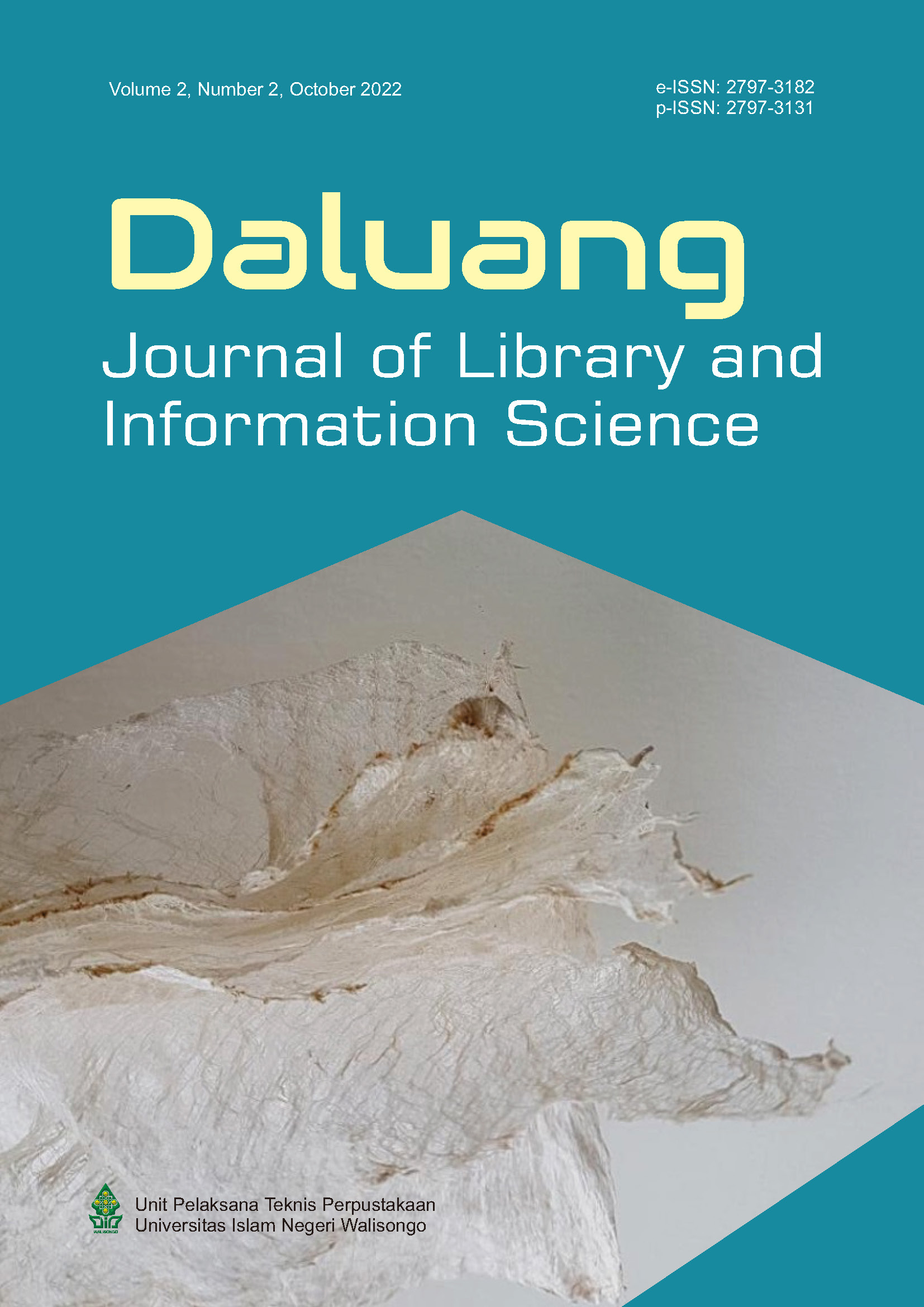Strategi pelestarian naskah kuno di Dinas Perpustakaan dan Kearsipan Provinsi Jawa Timur
Main Article Content
Abstract
Background. The implementation of preservation at The Library and Archives of East Java Province is less than optimal. This study aims to determine the strategies and efforts to develop the preservation of library materials at the Office of the Library and Archives of East Java Province, especially in the preservation of ancient manuscripts that are threatened with damage or loss due to physical damage.
Methodology. This research is a descriptive research method with a quantitative and qualitative approach. The selection of informants in this study used the entire population of librarians in the field of preservation.
Results and discussion. The results of this study show that the IFAS matrix shows that the strength and weakness factors have a total score of 2.28. Because the total score is above 0.73 it means that it identifies a strong internal position, where this strength has good strengths in terms of product. Furthermore, the EFAS matrix shows that the opportunity factor with a value of 0.68 and the threat has a value of 1.17. The total score between opportunities and threats is 1.85, with this identifying that responded that it was known after using strengths with SO opportunities and strategies.
Conclusions. The right development strategy is SO and WO. SO strategies include improving the quality of deposit services, ancient manuscript services, and adding information repackaging services. And the WO strategy includes conducting conservation training for librarians, recruiting expert librarians with preservation qualifications, recruiting philologists, procuring preservation equipment, constructing standard preservation rooms or buildings.
Downloads
Article Details
This work is licensed under a Creative Commons Attribution-NonCommercial-NoDerivatives 4.0 International License.
Articles published in Daluang Journal of Library and information Science are available under Creative Commons Attribution Non-Commercial No Derivatives Licence (CC BY-NC-ND 4.0). Authors retain copyright in their work and grant Daluang Journal of Library and information Science right of first publication under CC BY-NC-ND 4.0. Users have the right to read, download, copy, distribute, print, search, or link to the full texts of articles in this journal, and to use them for any other lawful purpose.
Articles published in Daluang Journal of Library and information Science can be copied, communicated and shared in their published form for non-commercial purposes provided full attribution is given to the author and the journal. Authors are able to enter into separate, additional contractual arrangements for the non-exclusive distribution of the journal's published version of the work (e.g., post it to an institutional repository or publish it in a book), with an acknowledgment of its initial publication in this journal.
This copyright notice applies to articles published in Daluang Journal of Library and information Science volumes 1 onwards.
References
Ahmad, N. F. (2018). Praktik Jual Beli Naskah Kuno di Masyarakat. Nusa: Jurnal Ilmu Bahasa dan Sastra, 13(4), 623. https://doi.org/10.14710/nusa.13.4.623-634
Anyira, I., Onoriode, O. K., & Nwabueze, A. (2010). The role of libraries in the preservation and accessibility of indigenous knowledge in the Niger Delta region of Nigeria. Library Philosophy and Practice, 2010(JUN), 1–9.
Bahrudin, M. (2011). Strategi Preservasi Naskah Kuno: Sebuah Kajian Ilmu Pengetahuan dan Khazanah Bangsa Indonesia.
Bondar, A. (2020). Kontekstual Pelestarian Naskah Kuno/Manuskrip Dalam Menggali Kearifan Lokal sebagai Social Capital Membangun Bangsa: Sebuah Tinjauan UU No. 43/2007 tentang Perpustakaan. Media Pustakawan, 15(3), 106–113.
Ekwelem, V. O., Okafor, V. N., & Ukwoma, S. C. (2011). Preservation of cultural heritage: The strategic role of the library and information science professionals in South East Nigeria. Library Philosophy and Practice, 2011(SEPT).
Indrawan, R., & Yaniawati, R. P. (2014). Metodologi Penelitian Kuantitatif. Kualitatif, dan Campuran Untuk Manajemen, Pembangunan, dan Pendidikan, Bandung: Penerbit PT Refika Aditama.
Kementerian Ketenagakerjaan RI. (1998). Peraturan Menteri Ketenagakerjaan Republik Indonesia No.3/MEN/1998.
Mashuri, M., & Nurjannah, D. (2020). Analisis SWOT Sebagai Strategi Meningkatkan Daya Saing. JPS (Jurnal Perbankan Syariah), 1(1), 97–112. https://doi.org/10.46367/jps.v1i1.205
Moleong, L. J. (2011). Metodologi Penelitian Kualitatif. Metodologi Penelitian Kualitatif.
Nugraha, H. C., & Laugu, N. (2021). Pelestarian Naskah Kuno dalam Upaya Menjaga Warisan Budaya Bangsa di Perpustakaan Museum Dewantara Kirti Griya Tamansiswa Yogyakarta. Lentera Pustaka: Jurnal Kajian Ilmu Perpustakaan, Informasi dan Kearsipan, 7(1), 105–120. https://doi.org/10.14710/lenpust.v7i1.37694
Perpusnas, P. P. dan A. M. B. P. N. R. I. (2020). Norma, Standar, Prosedur dan Kriteria (NSPK) pelestarian naskah kuno.
Rangkuti, F. (2013). Analisis SWOT Teknik Membedah Kasus Bisnis. Gramedia Pustaka Utama.
Undang-undang Republik Indonesia Nomor 43 Tahun 2007 Tentang Perpustakaan, Pub. L. No. 43 (2007). https://jdih.perpusnas.go.id/file_peraturan/UU_No._43_Tahun_2007_tentang_Perpustakaan_.pdf
Saputra, P. B. (2021, April 3). Selamatkan Naskah Kuno. Jawa Pos Radar Solo. https://radarsolo.jawapos.com/daerah/solo/03/04/2021/selamatkan-naskah-kuno/
Utomo, Y. W. (2013, Juli 15). Naskah Kuno Indonesia Terus Mengalir ke Luar Negeri. KOMPAS.com. https://sains.kompas.com/read/2013/07/15/1712232/Naskah.Kuno.Indonesia.Terus.Mengalir.ke.Luar.Negeri



